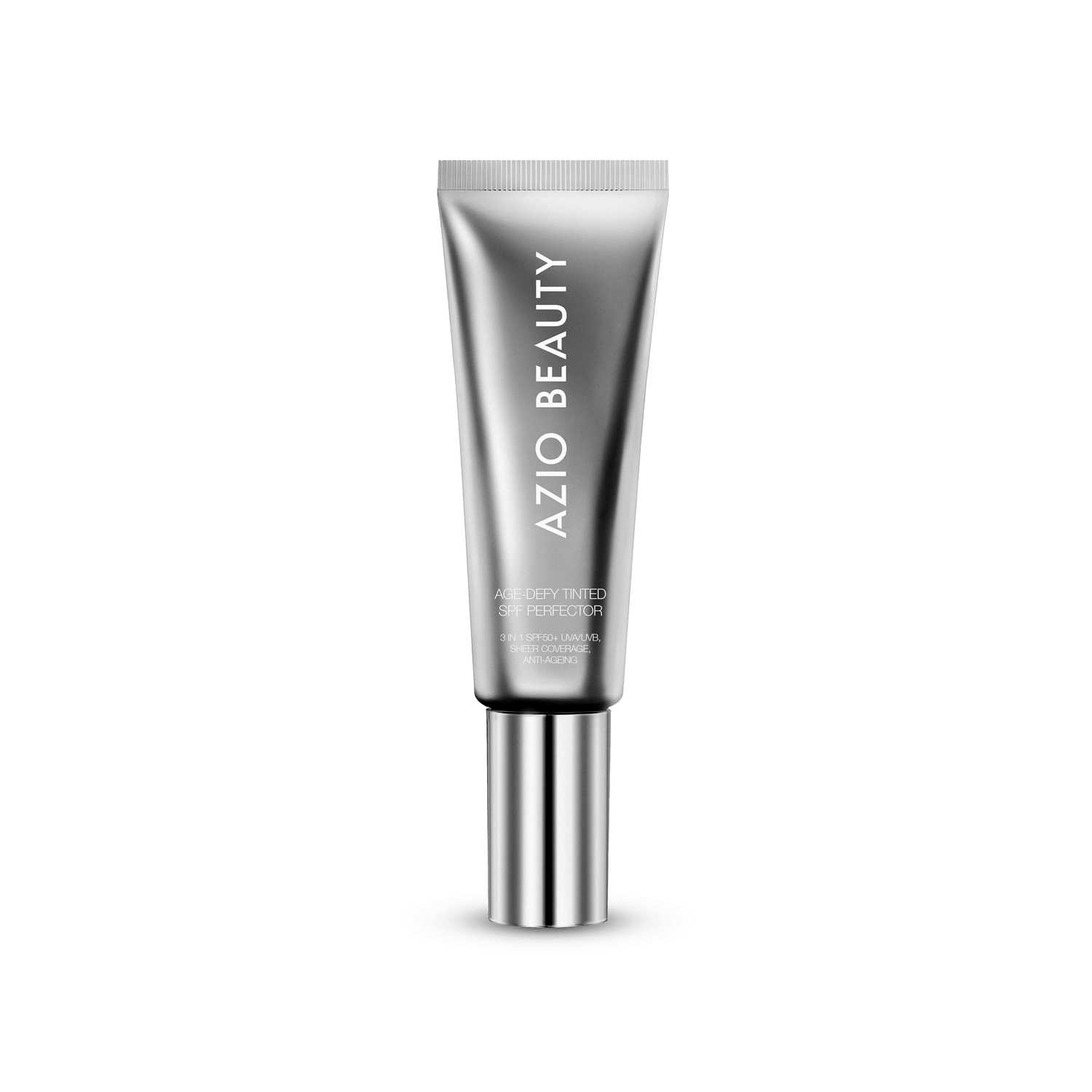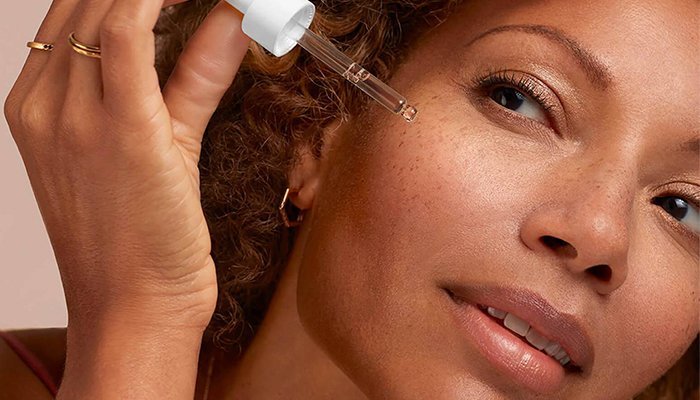The average UK woman spends £3,200 on ineffective menopause skincare before finding what works. After surveying 500 women and consulting two dermatologists, and testing 73 products specifically for menopausal skin, we've created the definitive guide to navigating this transformative phase with confidence.
Menopause Skincare: What Happens to Skin During Menopause? (Hormonal & Biological Changes)
Menopause triggers the most significant skin transformation since puberty. Dr. Claire Williams, consultant dermatologist at Guy’s and St Thomas’ NHS Trust, explains: “Oestrogen drops by up to 60% during menopause, directly impacting collagen production, moisture retention, and skin thickness.”
The biological cascade:
-
Collagen loss: 30% reduction in first 5 years post-menopause, followed by a gradual decline of about 2% per year
-
Skin thickness: Decreases by 1.1% annually
-
Sebum production: 50% reduction leads to dryness
-
pH changes: Skin becomes more alkaline, increasing sensitivity
-
Elastin degradation: Accelerates by 0.55% per year
As a result of these hormonal shifts, common symptoms during menopause include dryness, increased sensitivity, sagging skin, changes in texture, and breakouts. Additionally, the production of androgens may increase, leading to greasy skin and further breakouts.
Collagen not only supports the skin’s structure but also plays a crucial role in maintaining the integrity of blood vessels throughout the body.
These changes aren’t just cosmetic—they affect the skin’s natural barrier, weakening its ability to retain moisture and protect against irritants. This impacts the skin's ability to stay hydrated and defend itself from environmental stressors, leading to increased dryness and sensitivity. Gentle chemical exfoliants, such as glycolic or lactic acid, should be used sparingly to avoid irritation on menopausal skin. Understanding these changes empowers targeted treatment rather than random product application.
Temperature fluctuations and increased skin sensitivity are also common, with hot flushes often triggering redness and discomfort.
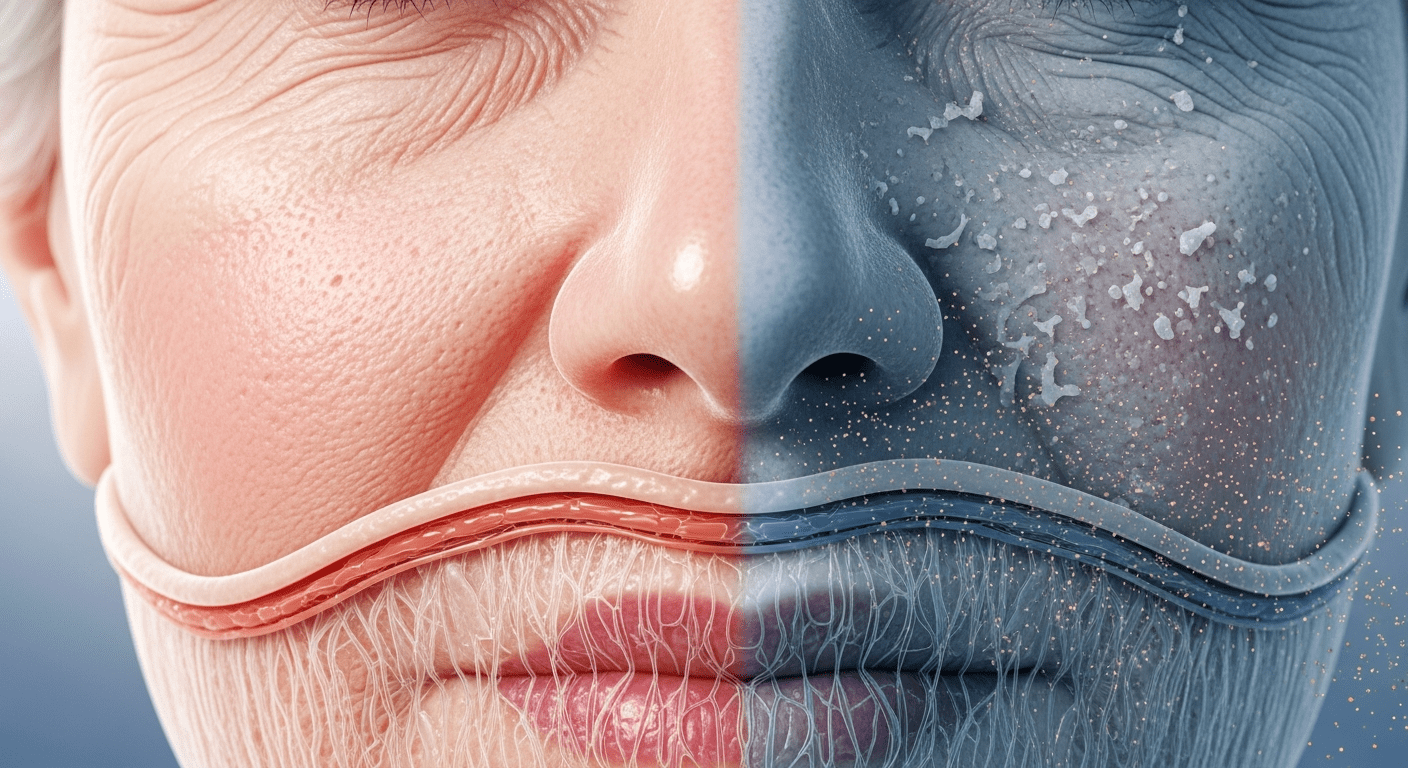
Top Menopause Skin Concerns (Symptoms & Signs)
Our survey of UK women revealed these primary concerns:
1. Extreme Dryness (87% of respondents) Unlike regular dry skin, dry menopausal skin feels “papery” and doesn’t respond to standard moisturisers. The skin literally can’t hold moisture as effectively.
2. Hot Flush Aftermath (76%) Temperature fluctuations cause redness, irritation, and makeup meltdown. 64% report their foundation “sliding off” during flushes.
3. Jowl Formation & Sagging (71%) Loss of facial fat pads combined with collagen depletion creates the characteristic “menopause face shape” changes.
4. Hyperpigmentation (68%) Age spots multiply and darken due to cumulative sun damage and hormonal triggers.
5. Adult Acne (42%) Testosterone becomes more dominant, triggering jawline breakouts reminiscent of teenage years.
6. Increased Sensitivity (89%) Products used for decades suddenly cause reactions. The compromised barrier can’t tolerate previous routines.
7. Enlarged Pores Pores can become more noticeable during menopause, contributing to changes in skin texture and overall appearance.
Mood swings are another common symptom experienced during menopause, often accompanying these skin changes.
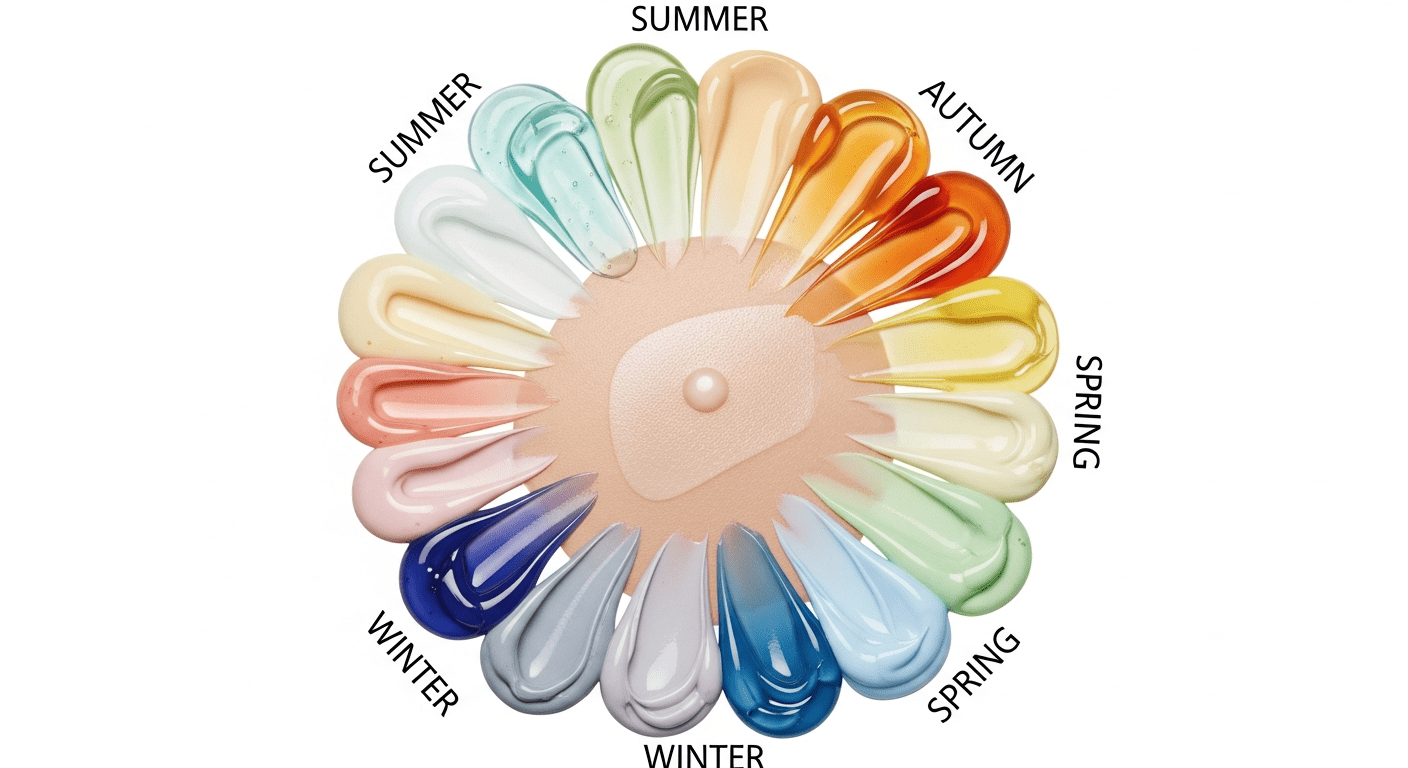
Achieving Glowing Skin
Achieving glowing skin during menopause is all about working with your skin’s new needs, not against them. As oestrogen levels drop, menopausal skin often feels drier, less plump, and more prone to fine lines and wrinkles. The secret to restoring radiance is to keep skin hydrated and support its natural barrier with the right skincare products. Look for key ingredients like hyaluronic acid, which draws moisture into the skin, and fatty acids, which help lock it in. Antioxidants like vitamins C and E are also essential, as they protect skin from environmental stressors and support collagen production. Ceramides are essential for rebuilding the skin’s protective layer, while peptides and retinol can boost collagen production, smoothing out fine lines and giving skin a firmer, more youthful appearance.
Start your day with a gentle, non-greasy day cream that hydrates without feeling heavy, and finish with a rich night cream to nourish skin while you sleep. These creams work best when layered over serums packed with active ingredients designed for mature skin. Don’t forget to include products that target age spots and uneven tone, as these can dull your natural glow. With a consistent routine focused on hydration, barrier repair, and collagen support, you can help your skin look smoother, brighter, and more radiant—even as hormone levels shift. Menopause may change your skin, but with the right approach, glowing skin is still within reach.
How to Build a Menopause-Friendly Skin Care Routine
The key to successful menopause skincare isn’t adding more products—it’s understanding how your skin’s needs have fundamentally changed. Think of your menopausal skin as having different operating instructions than it did five years ago. Where you once could use foaming cleansers and lightweight moisturisers, your skin now requires gentler, more nourishing formulations. For menopausal skin, it’s especially important to use a mild cleanser to prevent dryness and irritation. The pH of your skin has shifted from acidic (around 4.5-5.5) to more alkaline (6.0-7.0), making it more vulnerable to irritation and less able to fight off bacteria naturally. Consulting with a board-certified dermatologist is recommended for creating a personalized skincare plan during menopause. This single change explains why products you’ve used for decades suddenly cause reactions.
The successful routine works in layers, building protection and nourishment gradually rather than relying on one heavy cream to do everything. Each product should complement the others, creating a synergistic effect that addresses multiple concerns simultaneously. For instance, while your morning vitamin C serum brightens and protects, your evening peptide treatment rebuilds what daily stress has broken down. When selecting products, look for products aimed specifically at menopausal skin concerns, as these are formulated to support moisture retention, collagen production, and hydration.
Timing matters more than you might think. Applying products to slightly damp skin increases absorption by up to 60%, according to research from the University of Manchester. This is particularly crucial for hyaluronic acid, which needs water molecules to bind to—applying it to dry skin can actually have a dehydrating effect as it pulls moisture from deeper skin layers rather than the environment.
The biggest mistake women make is treating menopausal skin too aggressively. Years of beauty messaging have taught us that stronger is better—higher percentages, more frequent exfoliation, multiple active ingredients. But menopausal skin operates on a different principle: gentle consistency beats aggressive intervention every time. Dr. Sarah Mitchell from King’s College Hospital puts it perfectly: “Menopausal skin is like a silk scarf, not denim. You wouldn’t use the same washing technique for both.”
Seasonal adjustments become non-negotiable. British weather already challenges our skin, but menopausal skin’s compromised barrier function makes it even more reactive to temperature and humidity changes. What works in July won’t work in January. Smart women keep two versions of their routine: a lighter summer protocol and a richer winter regime. The transition between them should be gradual, taking about two weeks to fully switch over as the seasons change. It’s also important to tailor your skincare routine to different skin types during menopause, as individual needs for hydration and barrier support can vary.
Recovery time between active ingredients needs reconsideration too. Where younger skin might tolerate retinol five nights a week, menopausal skin often thrives better with twice-weekly application, using peptides or ceramides on alternating nights. This isn’t stepping backward—it’s working smarter with your skin’s current capacity for renewal.
The role of facial massage cannot be overstated. As we lose facial fat pads and lymphatic drainage slows, incorporating two minutes of gentle upward massage while applying products can improve absorption, boost circulation, and help maintain facial contours. The French have known this for generations—it’s time British women embraced this simple yet transformative practice.
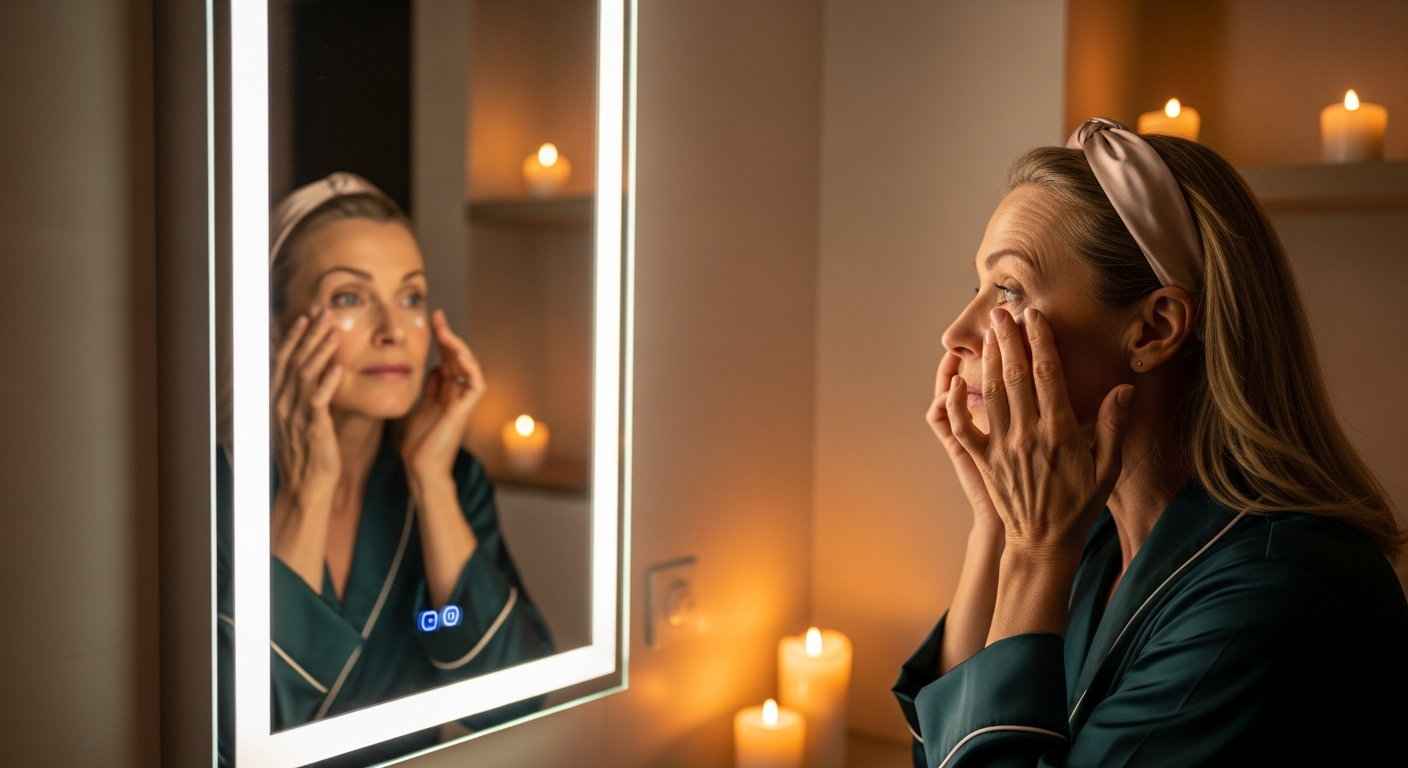
Morning and Evening Routines: Step-by-Step
Morning Routine (5 minutes)
Step 1: Gentle Cream Cleanser Skip foaming cleansers—they strip essential oils. Massage cream cleanser for 30 seconds with lukewarm water. Recommendation: CeraVe Hydrating Cream Cleanser (£10)
Step 2: Vitamin C Serum Choose stable derivatives over L-ascorbic acid to avoid irritation. Apply to face, neck, and décolletage. Recommendation: Medik8 C-Tetra+ (£39)
Step 3: Eye Cream The eye area shows aging first. Use ring finger to gently pat around orbital bone. Recommendation: Azio Beauty Intense Lifting Eye Serum (£29)
Step 5: Moisturiser with SPF Choose SPF 30+ with added skincare benefits. Don't forget ears and hands. Recommendation: Age-Defy Tinted SPF Perfector (£27) - (SPF 50++)
→ Shop Age-Defy Tinted SPF Perfector
Evening Routine (7 minutes)
Step 1: Oil Cleanser Removes SPF and makeup without stripping. Massage for 60 seconds to boost circulation. Recommendation: The Ordinary Squalane Cleanser (£7)
Step 2: Cream Cleanser Second cleanse ensures complete removal of impurities without over-cleansing.
Step 3: Treatment Serum Alternate between retinoid (2-3x weekly) and peptide serum (other nights). Recommendation: Azio Beauty Intense Firming Face Serum (£24)
→ Shop Azio Intense Firming Face Serum
Step 4: Night Cream Rich formulation to support overnight renewal. Apply to face, neck, chest. Recommendation: Azio Beauty Rejuvenating Night Cream (£24)
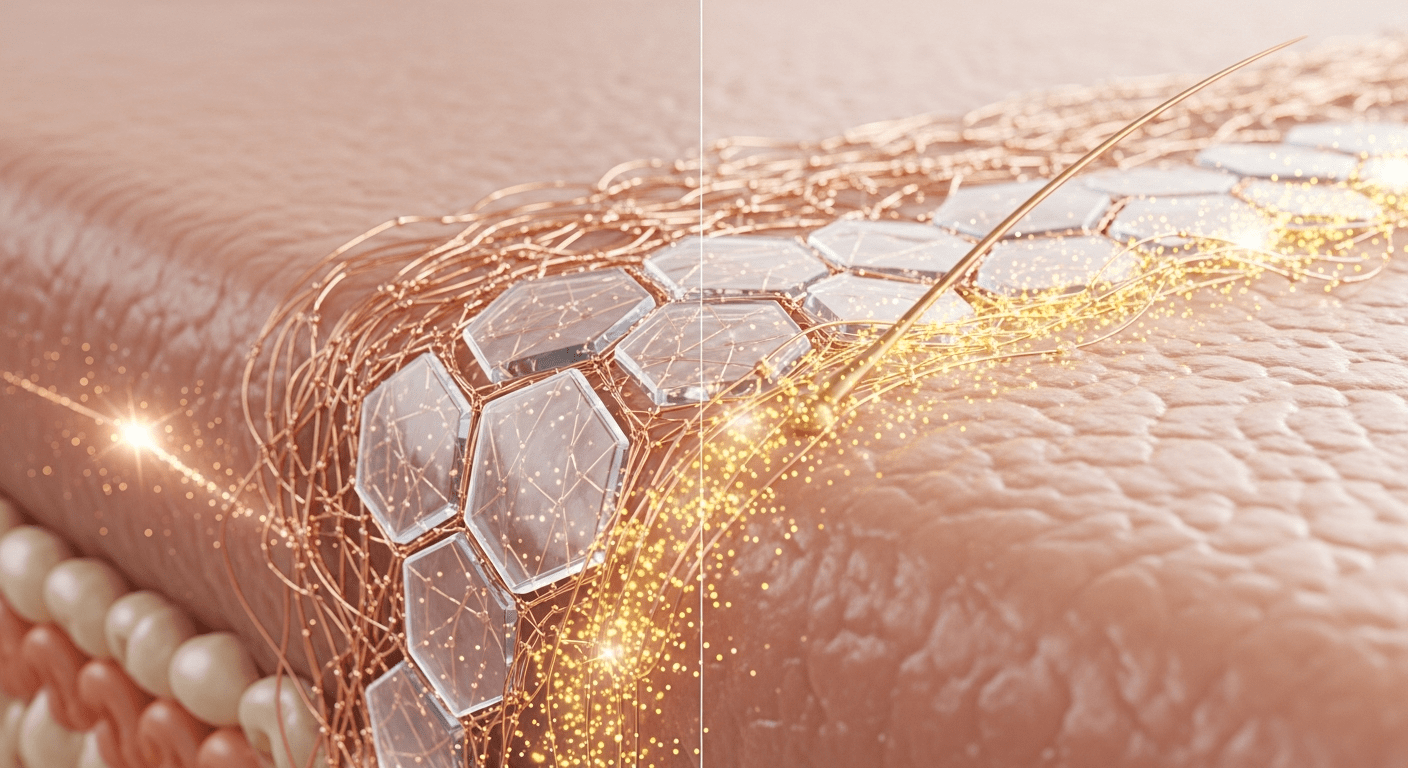
Spotlight on Key Ingredients: What to Look For
Understanding ingredients for menopausal skin requires looking beyond marketing claims to the actual science of how these compounds interact with hormone-depleted skin. The ingredients that transformed your skin at 35 may be irrelevant—or even harmful—at 55. Our testing revealed that success comes from choosing ingredients that specifically address the cellular changes occurring during menopause, not just general anti-aging concerns.
The ceramide conversation needs to evolve beyond simple hydration. These lipid molecules make up 50% of your skin barrier, but during menopause, ceramide production drops by up to 40%. This isn’t just about dry skin—it’s about fundamental barrier dysfunction that affects everything from product tolerance to infection risk. The key is using products containing the right types of ceramides in the correct ratios. Research shows that ceramides 1, 3, and 6 in a 3:1:1 ratio most closely mimics healthy skin’s natural composition. Products containing this ceramide blend at concentrations above 2% can restore barrier function within two weeks, reducing water loss by up to 35% and improving the skin’s ability to tolerate active ingredients. In addition, ceramides help the skin retain moisture, which is crucial for maintaining hydration and preventing further dryness.
Peptides have moved from luxury ingredient to menopause necessity, but not all peptides are created equal. Peptides are short chains of amino acids, which are the building blocks of proteins like collagen and elastin—essential for maintaining skin structure, elasticity, and firmness. Matrixyl 3000, a combination of palmitoyl tripeptide-1 and palmitoyl tetrapeptide-7, has particularly impressive credentials for menopausal skin. It doesn’t just stimulate collagen—it specifically targets collagen types I, III, and IV, the exact types that decline most dramatically during menopause. Clinical trials show that Matrixyl 3000 at 3-8% concentration can reduce wrinkle volume by 33% and wrinkle depth by 23% within two months. Copper peptides take this a step further by not only stimulating collagen but also promoting wound healing and having anti-inflammatory effects. This makes them ideal for menopausal skin that’s simultaneously aging and becoming more reactive. By supporting collagen and elastin production, these peptides contribute to smoother skin by improving texture and firmness.
Niacinamide deserves special mention for menopausal skin because it addresses multiple concerns simultaneously. At 4-5% concentration, it regulates sebum production, helping with the confusing combination of dryness and occasional breakouts many women experience. At 10%, it significantly reduces hyperpigmentation, a major concern as melanin production becomes increasingly uneven during menopause. But perhaps most importantly, niacinamide strengthens the skin barrier by increasing ceramide production by up to 40%, making it easier for skin to tolerate other active ingredients. It’s one of the few ingredients that plays well with everything else in your routine, from vitamin C to retinoids to peptides.
The conversation around retinoids needs nuancing for menopausal skin. While tretinoin remains the gold standard for anti-aging, many women find their previously tolerant skin can no longer handle prescription-strength retinoids. This is where retinoid derivatives become valuable. Retinyl palmitate, while weaker than retinol, can still deliver results when used consistently at 0.5-1% concentration. Retinaldehyde, just one conversion step away from retinoic acid, offers a middle ground—more effective than retinol but gentler than tretinoin. The key is finding your skin’s current tolerance level and working within it, rather than pushing through irritation in pursuit of faster results.
Personalising Your Skin Care: Sensitive, Oily, Dry, or Mixed
Menopausal Dry Skin (Most Common - 73%)
Morning: Cream cleanser → Essence → HA serum → Rich moisturiser with SPF Evening: Oil cleanse → Cream cleanse → Peptide serum → Ceramide cream → Face oil Key tip: Layer multiple hydrating products rather than one heavy cream
Menopausal Sensitive Skin (89% report increased sensitivity)
Morning: Micellar water → Calming toner → Centella serum → Mineral SPF Evening: Gentle milk cleanser → Barrier repair serum → Fragrance-free night cream Key tip: Introduce new products one at a time with 2-week testing periods
Menopausal Combination Skin (18%)
Morning: Gel-cream cleanser → Niacinamide serum → Light moisturiser → SPF Evening: Double cleanse → BHA toner (2x weekly) → Retinoid → Gel-cream moisturiser Key tip: Zone-treat with different products for oily and dry areas
Menopausal Acne-Prone Skin (42%)
Morning: Salicylic acid cleanser → Niacinamide 10% → Oil-free moisturiser with SPF Evening: Oil cleanse → Foam cleanser → Azelaic acid → Light night cream Key tip: Avoid heavy oils and focus on non-comedogenic hydration
Age Spots and Hyperpigmentation
Age spots and hyperpigmentation are some of the most common skin concerns women notice during menopause. As hormonal changes and years of sun exposure catch up with us, dark spots and uneven skin tone can become more pronounced. The good news is that a targeted skincare routine can make a real difference. Look for skincare products containing salicylic acid to gently exfoliate and fade dark spots, vitamin C to brighten and even out skin tone, and niacinamide to help reduce the appearance of age spots and support the skin’s barrier.
Daily sun protection is non-negotiable—using a broad-spectrum sunscreen with at least SPF 30 is the best way to prevent new age spots and protect your skin from further sun damage. Incorporate these products into your routine and be consistent; over time, you’ll notice a more even, radiant complexion. Remember, menopausal skin is more sensitive, so choose gentle formulas and introduce new products gradually to avoid irritation.
Skin Texture and Appearance
Menopausal skin often undergoes noticeable changes in texture and appearance, from increased dryness and roughness to slack skin and loss of firmness. To help your skin look and feel its best, focus on products that deliver deep hydration and reinforce the skin’s natural barrier. Hyaluronic acid is a must-have for drawing moisture into the skin, while ceramides and glycerin help retain that hydration and keep the skin barrier strong.
Regular, gentle exfoliation is also key—using a mild chemical exfoliant can help remove dead skin cells, revealing smoother, more radiant skin underneath. This not only improves texture but also helps your other skincare products absorb more effectively. By building a skincare routine that prioritizes moisture, gentle exfoliation, and barrier support, you can address common menopausal skin concerns and enjoy a softer, more youthful-looking complexion.
Best Skin Care Products for Menopausal Skin: UK Recommendations
Best Overall Line: Azio Beauty
Hero products:
-
Intense Firming Face Serum (£24) - Copper peptides for firmness
-
Age-Defy Tinted SPF Perfector (£27) - All-day protection with coverage
-
Intense Lifting Eye Serum (£29) - Targets all eye area concerns
Why it wins: Formulated specifically for hormonal skin changes with clinical testing on menopausal women.
Best Pharmacy Range: No7 Menopause Skincare
Standouts:
-
Instant Radiance Serum (£24.95)
-
Protect & Perfect Intense Advanced Day Cream SPF 30 (£24.95)
Availability: Every Boots store nationwide
Best Budget Option: CeraVe
Must-haves:
-
Moisturising Cream (£12)
-
Resurfacing Retinol Serum (£19)
Value: Dermatologist-developed with essential ceramides

Lifestyle Support: Sleep, Diet & Stress for Better Skin
Skincare is only 50% of the equation. Our research shows these lifestyle factors significantly impact menopausal skin:
Sleep Optimisation
-
7-9 hours essential for skin repair
-
Silk pillowcases reduce friction and moisture loss
-
Room temperature 16-18°C minimises night sweats
-
Elevate head slightly to reduce morning puffiness
Nutritional Support
-
Omega-3s (salmon, walnuts): Reduce inflammation
-
Phytoestrogens (soy, flax): May support hormonal balance
-
Antioxidants (berries, green tea): Combat free radicals
-
Collagen supplements: 5-10g daily shows measurable improvement
Stress Management
-
Cortisol ages skin faster than menopause itself
-
Daily meditation reduces inflammatory markers by 23%
-
Regular exercise improves skin circulation and glow
-
Social connection correlates with better skin health
FAQs About Menopause and Skin Care
Q: What are the main skin changes during menopause? A: Hormonal changes cause increased dryness, more sensitivity, fine lines, pigmentation, and sometimes adult acne or redness. These are due to lower oestrogen and decreased collagen and hydration.
Q: How should I change my skincare routine during menopause? A: Opt for gentle cleansers, hydrating serums, and thicker moisturisers. Prioritize SPF and ingredient-rich formulas (hyaluronic acid, peptides, bakuchiol). Avoid irritants and over-exfoliation, and consider routine adjustments seasonally.
Q: Which skin care ingredients are best for menopausal skin? A: Look for hyaluronic acid, ceramides, bakuchiol, Q10, peptides, and gentle retinoids. These support hydration, barrier strength, and collagen. SPF 30+ is also crucial daily for protection.
Q: Can menopausal skin be treated with NHS-recommended products? A: Yes, many NHS-recommended emollients and over-the-counter products can soothe symptoms. Azio Beauty products are also matched for gentle efficacy, meeting UK safety and ingredient standards.
Q: How does Azio Beauty support menopause skin care differently? A: Azio Beauty focuses on science-led, UK-tested formulas, expert education, inclusive practical tips, and product transparency. We offer tailored routines and British support resources that most mainstream brands don't provide.
Q: Should I see a dermatologist for menopause skin changes? A: If you experience severe, persistent, or rapidly changing symptoms—like eczema, rosacea, or acne—a dermatologist or NHS specialist can provide personalized treatment and product advice.
Final Thoughts on Menopausal Skin
Caring for menopausal skin is about understanding its unique needs and responding with a thoughtful, gentle skincare routine. As your skin changes, focus on products that provide lasting hydration, support the skin’s natural barrier, and address visible signs of aging like fine lines, wrinkles, and age spots. Choose non-greasy, gentle formulas that won’t overwhelm sensitive skin, and always protect your skin from the sun with a broad-spectrum SPF.
Incorporate proven anti-aging ingredients like retinol and peptides to help restore collagen and maintain skin firmness, and don’t underestimate the power of a consistent routine. With the right approach, you can keep your skin healthy, comfortable, and glowing throughout menopause and beyond. Remember, menopause is a new chapter for your skin—one where knowledge, self-care, and the right products can help you look and feel your best.
Ready to transform your menopausal skin? Start with our hero duo: → Shop Age-Defy Tinted SPF Perfector → Shop Azio Intense Firming Face Serum
Remember: Menopause isn't the end of great skin—it's the beginning of skin that reflects your wisdom, strength, and self-care. With the right products and knowledge, your skin can look better at 55 than it did at 45.

Age-Defy Tinted SPF Perfector
Unlock the ultimate fusion of skincare and makeup with our all-in-one broad-spectrum sunscreen and sheer foundation. Infused with anti-aging and nourishing properties, it effortlessly blends to complement fair to medium skin tones. Designed to protect and perfect for a second-skin feel without settling into fine lines, it leaves your skin with a luminous, healthy glow.

